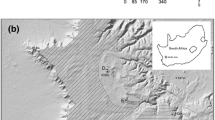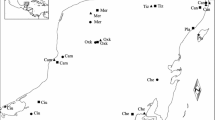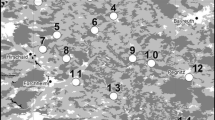Abstract
Habitat fragmentation is believed to be a key threat to biodiversity as it decreases the probability of survival of populations, reduces gene flow among populations and increases the possibility of inbreeding and loss of genetic diversity within populations. Heathlands represent excellent systems to study fragmentation effects as the spatial and temporal course of fragmentation is well documented for these habitats. At the beginning of the nineteenth century, heathlands were widespread in northern Germany, but they became increasingly fragmented at the end of the nineteenth century until only few fragments had been left. As many insect species are strongly specialized on heathland habitats, they represent ideal study systems to test the genetic effects of such recent fragmentation processes. The solitary bee Andrena fuscipes is strongly specialized on heather (Calluna vulgaris) and, therefore, occurs exclusively in heathland habitats. The species is red-listed in Germany and other parts of Europe. Here, we present an analysis of the genetic structure of 12 populations of A. fuscipes using eight microsatellite loci. The populations showed little geographical structure and the degree of genetic differentiation was low. Compared to related bee species, inbreeding coefficients were relatively low and seem to be mainly affected by the bees’ solitary nesting behaviour.




Similar content being viewed by others
References
Assmann T, Janssen J (1999) The effects of habitat changes on the endangered ground beetle Carabus nitens (Coleoptera: Carabidae). J Insect Conserv 3:107–116
Bakker JP, Berendse F (1999) Constraints in the restoration of ecological diversity in grassland and heathland communities. Trends Ecol Evol 14:63–68
Beveridge M, Simmons LW (2006) Panmixia: an example from Dawson’s burrowing bee (Amegilla dawsoni) (Hymenoptera: Anthophorini). Mol Ecol 15:951–957
Biesmeijer JC, Roberts SPM, Reemer M, Ohlemuller R, Edwards M, Peeters T, Schaffers AP, Potts SG, Kleukers R, Thomas CD, Settele J, Kunin WE (2006) Parallel declines in pollinators and insect-pollinated plants in Britain and the Netherlands. Science 313:351–354
Bohonak AJ (2002) IBD (Isolation by Distance): a program for analysis of isolation by distance. J Hered 93:153–154
Callen DF, Thompson AD, Shen Y, Phillips HA, Richards RI, Mulley JC, Sutherland GR (1993) Incidence and origin of “null” alleles in the (AC)n microsatellite markers. Am J Hum Genet 52:922–927
Cane JH, Tepedino VJ (2001) Causes and extent of declines among native North American invertebrate pollinators: detection, evidence, and consequences. Conserv Ecol 5:1
Carlsson J (2008) Effects of microsatellite null alleles on assignment testing. J Hered 99:616–623
Cavalli-Sforza LL, Edwards AWF (1967) Phylogenetic analysis. Models and estimation procedures. Am J Hum Genet 19:233–257
Chapman RE, Wang J, Bourke AFG (2003) Genetic analysis of spatial foraging patterns and resource sharing in bumble bee pollinators. Mol Ecol 12:2801–2808
Corander J, Marttinen P (2006) Bayesian identification of admixture events using multi-locus molecular markers. Mol Ecol 15:2833–2843
Cornuet JM, Luikart G (1996) Description and power analysis of two tests for inferring recent population bottlenecks from allele frequency data. Genetics 144:2001–2014
Dakin EE, Avise JC (2004) Microsatellite null alleles in parentage analysis. Heredity 93:504–509
Danforth BN, Shuqing J, Ballard LJ (2003) Gene flow and population structure in an oligolectic desert bee, Macrotera (Macroteropsis) portalis (Hymenoptera: Andrenidae). J Kans Entomol Soc 76:221–235
Dupont YL, Nielsen BO (2006) Species composition, feeding specificity and larval trophic level of flower-visiting insects in fragmented versus continuous heathlands in Denmark. Biol Conserv 131:475–485
El Mousadik A, Petit RJ (1996) High level of genetic differentiation for allelic richness among populations of the argan tree [Argania spinosa (L.) Skeels] endemic to Morocco. Theor Appl Genet 92:832–839
Ellis JS, Knight ME, Darvill B, Goulson D (2006) Extremely low effective population sizes, genetic structuring and reduced genetic diversity in a threatened bumblebee species, Bombus sylvarum (Hymenoptera: Apidae). Mol Ecol 15:4375–4386
Exeler N, Kratochwil A, Hochkirch A (2008) Strong genetic exchange among populations of a specialist bee, Andrena vaga (Hymenoptera: Andrenidae). Conserv Genet 9:1233–1241
Exeler N, Kratochwil A, Hochkirch A (2009) Restoration of riverine inland sand dunes: implications for the conservation of wild bees (Apoidea). J Appl Ecol 46:1097–1105
Fahrig L (2003) Effects of habitat fragmentation on biodiversity. Annu Rev Ecol Syst 34:487–515
Felsenstein J (1993) Phylip (Phylogeny Inference Package) v3.57c. Department of Genetics, University of Washington, Seattle
Fischer J, Lindenmayer DB (2007) Landscape modification and habitat fragmentation: a synthesis. Glob Ecol Biogeogr 16:265–280
Fitzpatrick U, Murray TE, Byrne A, Paxton RJ, Brown MJF (2006) Regional red list of Irish bees. Report to National Parks and Wildlife Service (Ireland) and Environment and Heritage Service (N. Ireland). http://www.npws.ie/en/media/Media,4860,en.pdf. Accessed Nov 2006
Gathmann A, Tscharntke T (2002) Foraging ranges of solitary bees. J Anim Ecol 45:742–752
Goudet J (1995) FSTAT (Version 1.2): a computer program to calculate F statistics. J Hered 86:485–486
Gröning J, Krause S, Hochkirch A (2007) Habitat preferences of an endangered insect species, Cepero’s ground-hopper (Tetrix ceperoi). Ecol Res 22:767–773
Heckenroth H (1985) Atlas der Brutvögel Niedersachsens 1980. Naturschutz Landschaftspfl Niedersachs 14:1–428
Hochkirch A, Damerau M (2009) Rapid range expansion of a wing-dimorphic bush-cricket after the 2003 climatic anomaly. Biol J Linn Soc 97:118–127
Hochkirch A, Witzenberger K, Teerling A, Niemeyer F (2007) Translocation of an endangered insect species, the field cricket (Gryllus campestris Linnaeus, 1758) in northern Germany. Biodivers Conserv 16:3597–3607
Hochkirch A, Gärtner A-C, Brandt T (2008) Effects of management of degraded inland dunes on the endangered heath grasshopper, Chorthippus vagans (Orthoptera: Acrididae). Bull Entomol Res 98:449–456
Kelley ST, Farrell BD, Mitton JB (2000) Effects of specialization on genetic differentiation in sister species of bark beetles. J Hered 84:218–227
Keyghobadi N, Roland J, Strobeck C (2005) Genetic differentiation and gene flow among populations of the alpine butterfly, Parnassius smintheus, vary with landscape connectivity. Mol Ecol 14:1897–1909
Kitahara M, Fujii K (1994) Biodiversity and community structure of temperate butterfly species within a gradient of human disturbance: an analysis based on the concept of generalist vs. specialist strategies. Res Popul Ecol 36:187–199
Latch EK, Dharmarajan G, Glaubitz JC, Rhodes OE (2006) Relative performance of Bayesian clustering software for inferring population substructure and individual assignment at low levels of population differentiation. Conserv Genet 7:295–302
Minch E (1997) Microsat, version 1.5b. Stanford University Medical Centre, Stanford, CA
Mohra C, Fellendorf M, Segelbacher G, Paxton RJ (2000) Dinucleotide microsatellite loci for Andrena vaga and other andrenid bees from non-enriched and CT-enriched libraries. Mol Ecol 9:2189–2191
Packer L, Owen R (2001) Population genetic aspects of pollinator decline. Conserv Ecol 5. http://www.consecol.org/vol5/iss1/art4/
Packer L, Zayed A, Grixti JC, Ruz L, Owen RE, Vivallo F, Toro H (2005) Conservation genetics of potentially endangered mutualisms: reduced levels of genetic variation in specialist versus generalist bees. Conserv Biol 19:195–202
Paxton RJ (2005) Male mating behaviour and mating systems of bees: an overview. Apidologie 36:145–156
Paxton RJ, Thorén PA, Tengö J, Estoup A, Pamilo P (1996) Mating structure and nestmate relatedness in a communal bee, Andrena jacobi (Hymenoptera, Andrenidae), using microsatellites. Mol Ecol 5:511–519
Peakall R, Smouse PE (2006) GenAlEx 6: genetic analysis in Excel. Population genetic software for teaching and research. Mol Ecol Notes 6:288–295
Peeters TMJ, Reemer M (2003) Bedreigde en verdwenen bijen in Nederland (Apidae). European Invertebrate Survey, Nederland, Leiden
Peterson MA, Denno R (1998) The influence of dispersal and diet breadth on patterns of genetic isolation by distance in phytophagous insects. Am Nat 152:428–446
Petit E, Balloux F, Goudet J (2001) Sex biased dispersal in a migratory bat: a characterization using sex-specific demographic parameters. Evolution 55:635–640
Pritchard JK, Stephens M, Donnelly P (2000) Inference of population structure using multilocus genotype data. Genetics 155:945–959
R Development Core Team (2008) R: a language and environment for statistical computing. http://www.R-project.org
Raymond M, Rousset F (1995) Genepop (version 1.2): population genetics software for exact tests and ecumenicism. J Hered 86:248–249
Riecken U, Finck P, Raths U, Schröder E, Ssymank A (2006) Rote Liste der gefährdeten Biotoptypen Deutschlands. Zweite fortgeschriebene Fassung 2006. Schriftenreihe Naturschutz und Biologische Vielfalt, vol 34. Bundesamt für Naturschutz, Bonn
Sallé A, Arthofer W, Lieutier F, Stauffer C, Kerdelhué C (2007) Phylogeography of a host-specific insect: genetic structure of Ips typographus in Europe does not reflect past fragmentation of its host. Biol J Linn Soc 90:239–246
Sedláková I, Chytrý M (1999) Regeneration patterns in a Central European dry heathland: effects of burning, sod-cutting and cutting. Plant Ecol 143:77–87
Stahlhut JK, Cowan DP (2004) Inbreeding in a natural population of Euodynerus foraminatus (Hymenoptera: Vespidae), a solitary wasp with single-locus complementary sex determination. Mol Ecol 13:631–638
Steffan-Dewenter I, Tscharntke T (1999) Effects of habitat isolation on pollinator communities and seed set. Oecologia 121:432–440
Stow A, Silberbauer L, Beattie AJ, Briscoe DA (2007) Fine-scale genetic structure and fire-created habitat patchiness in the Australian allodapine bee, Exoneura nigrescens (Hymenoptera: Apidae). J Hered 98:60–66
Tscharntke T (1992) Fragmentation of Phragmites habitats, minimum viable population size, habitat suitability, and local extinction of moths, midges, flies, aphids, and birds. Conserv Biol 6:530–536
Tscharntke T, Brandl R (2004) Plant–insect interactions in fragmented landscapes. Annu Rev Entomol 49:405–430
Usher MB (1992) Management and diversity of arthropods in Calluna heathland. Biodivers Conserv 1:63–79
Van Oosterhout C, Hutchinson WF, Wills DPM, Shipley P (2004) Micro-checker: software for identifying and correcting errors in microsatellite data. Mol Ecol Notes 4:535–538
von der Heide A, Metscher H (2003) Zur Bienen- und Wespenbesiedlung von Taldünen der Ems und anderen Trockenstandorten im Emsland (Hymenoptera; Aculeata). Drosera 1:95–130
Webb NR (1989) Studies on the invertebrate fauna of fragmented heathland in Dorset, UK, and the implications for conservation. Biol Conserv 47:153–165
Westrich P (1989) Die Wildbienen Baden Württembergs. Eugen Ulmer, Stuttgart
Westrich P, Schwenninger HR, Dathe H, Riemann H, Saure C, Voith J, Weber K (1998) Rote Liste der Bienen (Hymenoptera, Apidae). In: Riecken U, Finck P, Raths U, Schröder E, Ssymank A (eds) Rote Liste gefährdeter Tiere Deutschlands, vol 55. Bundesamt für Naturschutz (Hrsg), Schriftenreihe Landschaftspflege und Naturschutz, pp 119–129
Widmer A, Schmid-Hempel P (1999) The population genetic structure of a large temperate pollinator species, Bombus pascuorum (Scopoli) (Hymenoptera: Apidae). Mol Ecol 8:387–398
Witzenberger KA, Hochkirch A (2008) Genetic consequences of animal translocations: a case study using the field cricket, Gryllus campestris L. Biol Conserv 141:3059–3068
Wright S (1951) The genetic structure of populations. Ann Eugen 15:323–354
Wuellner CT (1999) Nest site preference and success in a gregarious, ground nesting bee Dieunomia triangulifera. Ecol Entomol 24:471–479
Zayed A, Packer L, Grixti JC, Ruz L, Owen RE, Toro H (2005) Increased genetic differentiation in a specialist versus a generalist bee: implications for conservation. Conserv Genet 6:1017–1026
Acknowledgements
We are grateful to A. Schanowski, C. Venne and S. Hameister for collecting material of A. fuscipes. We thank U. Coja for help in the laboratory. K. A. Witzenberger and T. Eggers gave helpful comments on a previous version of this manuscript. We also wish to thank R. Paxton for providing microsatellite primers and helpful comments. Financial support was provided by the German Federal Environmental Foundation (“Deutsche Bundesstiftung Umwelt”) and the Environmental Foundation of Weser-Ems (“Umweltstiftung Weser-Ems”). We thank the regional administrations for the permission to collect specimens of A. fuscipes.
Author information
Authors and Affiliations
Corresponding author
Electronic supplementary material
Below is the link to the electronic supplementary material.
Rights and permissions
About this article
Cite this article
Exeler, N., Kratochwil, A. & Hochkirch, A. Does recent habitat fragmentation affect the population genetics of a heathland specialist, Andrena fuscipes (Hymenoptera: Andrenidae)?. Conserv Genet 11, 1679–1687 (2010). https://doi.org/10.1007/s10592-010-0060-5
Received:
Accepted:
Published:
Issue Date:
DOI: https://doi.org/10.1007/s10592-010-0060-5




